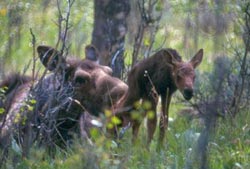For juvenile moose, momma's boys and girls fare best

This is a moose mother and her newborn calf.<br>Credit: Dr. Joel Berger<br>
Based on ten years of fieldwork in the Tetons of Wyoming, WCS Conservation Biologist, University of Montana Professor and study author Dr. Joel Berger looked at whether body size of juvenile moose and maternal presence were related to survival of the young animals.
In animals from elk to lizards and fish, size matters, and larger individuals enjoy a survival advantage. However, results of Berger's study showed that for juvenile moose, body mass had no significant effect on overwinter survival. Maternal presence did.
The study, “Estimation of Body-Size Traits by Photogrammetry in Large Mammals to Inform Conservation” appears in the early view section of the on-line edition of the journal Conservation Biology.
The study found that orphaned moose in their first winter were subjected to 8 to 47 times more aggression from adult moose than were young moose whose mothers were present. Overall, the survival of orphan calves was about 8 times lower than those with mothers.
Along with facing more aggression from kicking by adult females and being displaced from the best feeding areas, Berger theorized that orphans incur greater metabolic costs and expend more energy in deep snow. Why orphans were attacked more was not clear, but Berger raised the possibility that mothers were trying to maintain more resources for their own offspring.
“These findings highlight the importance of maternal presence rather than body size and suggest policy changes may be warranted in how harvest quotas are set,” said Berger. “In some circumstances, the shooting of mothers with young has been permitted under the assumption that calf survival is minimally affected. Clearly, that is not the case.”
In another development from the study, Berger pioneered a new method to estimate the size of juveniles without resorting to immobilization by darting or netting by helicopters – both methods that are stressful to wildlife. Instead, Berger used photogrammetry—a process of using photographs to determine the properties of objects. Digitally measuring head sizes on photographs enabled estimation of juvenile body mass in a quick and non-invasive fashion.
Berger said, “Other methods of acquiring data on large animals are exhaustive, expensive and more invasive. Photogrammetric assessment has shown to be accurate, widely deployable and much easier on the animals and scientists, and the findings in this study illustrate the method can be used to inform conservation planning.”
Media Contact
More Information:
http://www.wcs.orgAll latest news from the category: Ecology, The Environment and Conservation
This complex theme deals primarily with interactions between organisms and the environmental factors that impact them, but to a greater extent between individual inanimate environmental factors.
innovations-report offers informative reports and articles on topics such as climate protection, landscape conservation, ecological systems, wildlife and nature parks and ecosystem efficiency and balance.
Newest articles

Silicon Carbide Innovation Alliance to drive industrial-scale semiconductor work
Known for its ability to withstand extreme environments and high voltages, silicon carbide (SiC) is a semiconducting material made up of silicon and carbon atoms arranged into crystals that is…

New SPECT/CT technique shows impressive biomarker identification
…offers increased access for prostate cancer patients. A novel SPECT/CT acquisition method can accurately detect radiopharmaceutical biodistribution in a convenient manner for prostate cancer patients, opening the door for more…

How 3D printers can give robots a soft touch
Soft skin coverings and touch sensors have emerged as a promising feature for robots that are both safer and more intuitive for human interaction, but they are expensive and difficult…





















